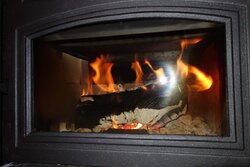I am a little confused now. I had the best burn when the temperature outside was the lowest. How do I get a hotter burn. I am sure that my wood is dry enough. I guess I will order the thermometer mentioned in previous post here:
http://www.condar.com/Stovetop_Thermometers.html. In the meantime how do I get hotter burns. I run the stove hot for an hour and then turn it midway and still not seeing the good secondary burns where the flames shoot out the holes on the top. Does more draft from colder temperatures actually make the stove hotter and get good secondary burns. Does there have to be a certain draft to get these secondary burns. Stove top seems as hot as can be now. Currently running stove with 55 degrees outside and flame seems good but no secondary burns. Also should I not use the blower fan until I get good secondary burns. I will post a picture of the burn now.
As the outside temps get lower, it will burn better. First off, if you running the stove for an hour at wide open air, (unless it is from a cold start)your letting more heat go up the stack, and not going to get the secondary burn as well as at lower air settings. Try setting the air down in stages, full to get it going well, then 3/4 to 1/2 for another 15 or so, then I would say minimal is at least 3/4 closed.
For instance, I get it ripping,( from cold start depending on wood, etc, anywhere from 20-30 minutes to 45 mins an hour, then cut air back, for me gradually till full low) then go to 1/2 closed for another 10- 15 minutes, then, in my case, I close it all the way to full low. On a reload with coals, more like 15 mins, then 1/2, 5-10 mins to full low).
After that the secondaries are full bore, you may even some flame jets from the front lower boost manifold holes. The temp at that point raises on it's own and levels out anywhere from 650-750. Burning at 1/2 open air is letting more heat up and out, actually bypassing the secondaries some. The key is, to get it hot, and then cut the air down as far as you can, yet not smoulder it. You will have to experiment until you get quite a few burns under your belt, with your stove in your setup in your home.
For years I honed how I burnt, sizes, species, air settings, and went from loading 3x a day, every 8 hours, to loading 2x a day, every 12 hours. The first year is the learning year. The next year and several following, you will hone your skills and knowledge of your stove, skills and habits, wood etc, and you will be amazed at how instinctive it comes, and how much less wood you burn, all the while getting more heat from the same loads, but with better skills.
A thermo is merely a reference. After a while you will rely less on the thermo, and more on instinct and visual of the burn stages.
The only time the stove should smoke is when you first start a cold start, or relaod. If it smokes after that, you're not burning hot enough. Load size really doesn't matter(accept on cold starts), burn temp does. Small load or large load, it will reach same temps, maybe slightly less, but merely burning less longer for smaller loads.
If you see "white" smoke out of the stack, especially when it is really frigid outside, that is only steam, and normal. After a while you should see only wavy clear flow out of the stack, that is optimal, clean burn.
The trick is, to get the stove burning without smouldering, with the air set as low as possible. Less air open, = more heat to home, and less up the stack, and a cleaner, longer, more efficient burn.
Don't stress yourself out, it will come to you with each subsequent burn.
You have many good folks for resources here, never be afraid to ask questions. We all did, and still do. Make it something to enjoy, not stress you out.


